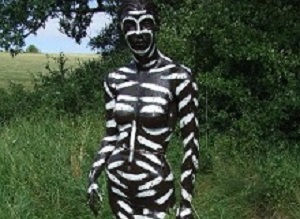 A study by researchers from Sweden and Hungary shows that white, painted stripes on the body protect skin from insect bites. It is the first time researchers have successfully shown that body-painting has this effect. Among indigenous peoples who wear body-paint, the markings thus provide a certain protection against insect-borne diseases.
A study by researchers from Sweden and Hungary shows that white, painted stripes on the body protect skin from insect bites. It is the first time researchers have successfully shown that body-painting has this effect. Among indigenous peoples who wear body-paint, the markings thus provide a certain protection against insect-borne diseases.
Most of the indigenous communities who paint their bodies live in areas where there is an abundance of bloodsucking horseflies, mosquitoes or tsetse flies. When these insects bite people there is a risk of bacteria, parasites and other pathogens being transferred.
The study shows that body-painting provides protection against the insects. A brown plastic model of a human attracted ten times as many horseflies as a dark model painted with white stripes. The researchers also found that a beige-coloured plastic figure used as a control model attracted twice as many bloodsuckers as the striped model.
According to Susanne Åkesson, professor at Lund University's department of biology, the tradition of body-painting may have developed simultaneously on different continents. It is not known when the tradition started.
"Body-painting began long before humans started to wear clothes. There are archaeological finds that include markings on the walls of caves where Neanderthals lived. They suggest that they had been body-painted with earth pigments such as ochre," says Åkesson.
The research team has previously observed that the zebra's stripes act as protection against horseflies. It is also known that pale fur, on horses for example, can provide protection, in contrast to dark fur. The discovery won the IgNobel Prize in Physics in 2016. In the new study, the team has taken the research a step further and examined plastic models that are the same size as adult humans.
For the experiments, which were conducted in Hungary, the researchers painted three plastic models of humans: one dark, one dark with pale stripes and one beige. They then covered the three models with a layer of insect glue. The dark model attracted ten times more horseflies than the striped model, and the beige model attracted twice as many as the striped one.
They also examined whether the attraction of horseflies differed between models that were lying down or standing up. The results show that only females were attracted to the standing models, whereas both males and females were drawn to the supine models.
"These results are in line with previous experiments in which we showed that males gravitate towards water in order to drink and land on surfaces that reflect horizontal, linear polarised light, such as signals from a water surface. Females that bite and suck blood from host animals respond to the same signals as the males, but also to light signals from in the vertical plane, such as the standing models," concludes Åkesson.
Abstract
Bodypainting is widespread in African, Australian and Papua New Guinean indigenous communities. Many bodypaintings use white or bright yellow/grey/beige stripes on brown skin. Where the majority of people using bodypainting presently live, blood-sucking horseflies are abundant, and they frequently attack the naked brown regions of the human body surface with the risk of transmitting the pathogens of dangerous diseases. Since horseflies are deterred by the black and white stripes of zebras, we hypothesized that white-striped paintings on dark brown human bodies have a similar effect. In a field experiment in Hungary, we tested this hypothesis. We show that the attractiveness to horseflies of a dark brown human body model significantly decreases, if it is painted with the white stripes that are used in bodypaintings. Our brown human model was 10 times more attractive to horseflies than the white-striped brown model, and a beige model, which was used as a control, attracted two times more horseflies than the striped brown model. Thus, white-striped bodypaintings, such as those used by African and Australian people, may serve to deter horseflies, which is an advantageous byproduct of these bodypaintings that could lead to reduced irritation and disease transmission by these blood-sucking insects.
Authors
Gábor Horváth, Ádám Pereszlényi, Susanne Åkesson, György Kriska
[link url="https://www.lunduniversity.lu.se/article/body-painting-protects-against-bloodsucking-insects"]Lund University material[/link]
[link url="https://royalsocietypublishing.org/doi/10.1098/rsos.181325"]Royal Society Publishing abstract[/link]
